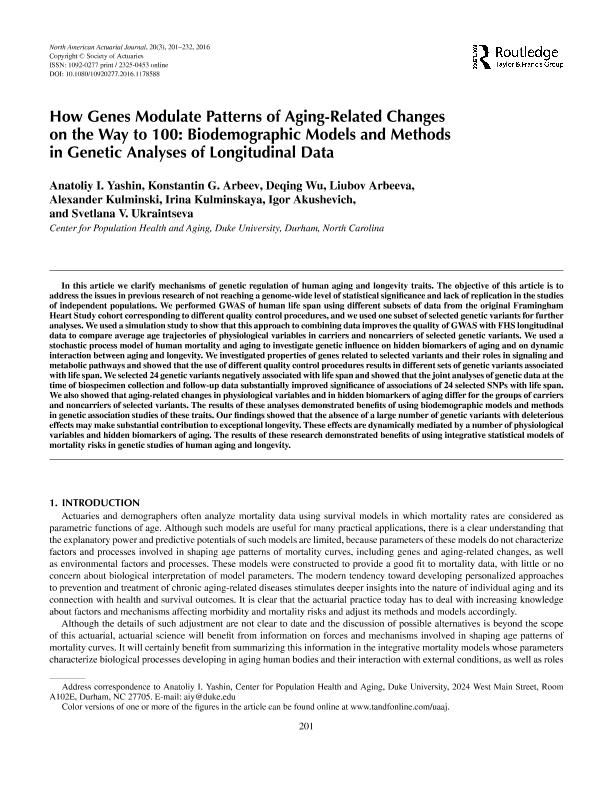How genes modulate patterns of aging-related changes on the way to 100 : biodemographic models and methods in genetic analyses of longitudinal data

Contenido multimedia no disponible por derechos de autor o por acceso restringido. Contacte con la institución para más información.
| Tag | 1 | 2 | Valor |
|---|---|---|---|
| LDR | 00000cab a2200000 4500 | ||
| 001 | MAP20160034165 | ||
| 003 | MAP | ||
| 005 | 20161123173427.0 | ||
| 008 | 161117e20160905usa|||p |0|||b|eng d | ||
| 040 | $aMAP$bspa$dMAP | ||
| 084 | $a6 | ||
| 245 | 0 | 0 | $aHow genes modulate patterns of aging-related changes on the way to 100$b: biodemographic models and methods in genetic analyses of longitudinal data$cAnatoliy I. Yashin... [et al.] |
| 520 | $aIn this article it is clarify mechanisms of genetic regulation of human aging and longevity traits. The objective of this article is to address the issues in previous research of not reaching a genome-wide level of statistical significance and lack of replication in the studies of independent populations. We performed GWAS of human life span using different subsets of data from the original Framingham Heart Study cohort corresponding to different quality control procedures, and we used one subset of selected genetic variants for further analyses. We used a simulation study to show that this approach to combining data improves the quality of GWAS with FHS longitudinal data to compare average age trajectories of physiological variables in carriers and noncarriers of selected genetic variants. We used a stochastic process model of human mortality and aging to investigate genetic influence on hidden biomarkers of aging and on dynamic interaction between aging and longevity. We investigated properties of genes related to selected variants and their roles in signaling and metabolic pathways and showed that the use of different quality control procedures results in different sets of genetic variants associated with life span. We selected 24 genetic variants negatively associated with life span and showed that the joint analyses of genetic data at the time of biospecimen collection and follow-up data substantially improved significance of associations of 24 selected SNPs with life span. We also showed that aging-related changes in physiological variables and in hidden biomarkers of aging differ for the groups of carriers and noncarriers of selected variants. The results of these analyses demonstrated benefits of using biodemographic models and methods in genetic association studies of these traits. Our findings showed that the absence of a large number of genetic variants with deleterious effects may make substantial contribution to exceptional longevity. These effects are dynamically mediated by a number of physiological variables and hidden biomarkers of aging. The results of these research demonstrated benefits of using integrative statistical models of mortality risks in genetic studies of human aging and longevity | ||
| 650 | 4 | $0MAPA20080579258$aCálculo actuarial | |
| 650 | 4 | $0MAPA20080555016$aLongevidad | |
| 650 | 4 | $0MAPA20080547424$aGenética | |
| 650 | 4 | $0MAPA20080580377$aEsperanza de vida | |
| 650 | 4 | $0MAPA20120015326$aGenoma humano | |
| 650 | 4 | $0MAPA20080597733$aModelos estadísticos | |
| 700 | 1 | $0MAPA20160014167$aYashin, Anatoliy I. | |
| 773 | 0 | $wMAP20077000239$tNorth American actuarial journal$dSchaumburg : Society of Actuaries, 1997-$x1092-0277$g05/09/2016 Tomo 20 Número 3 - 2016 , p. 201-232 |

